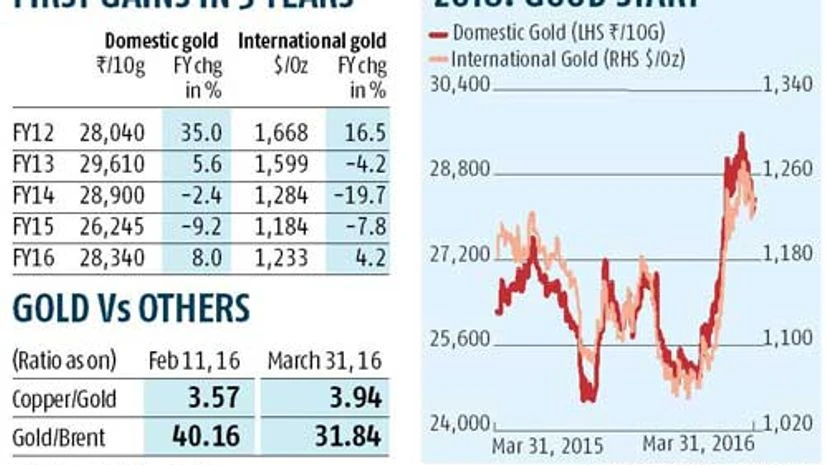The fundamentals of gold are changing, as is visible from the sharp rise in its price (see chart) and receding fears of a rate increase by the US Federal Reserve. Since mid-December, prices have rebounded from multi-year lows, led by huge demand, mainly from US investors. So, after three (financial) years of negative return, gold managed to end with some gain for the 12 months ended March 2016. In India, too, gold has delivered positive returns, after two years of loss.
However, since February, the yellow metal has come off a bit, due to profit booking and return of risk appetite. While gold might consolidate or see some more profit booking in the near term, experts say the fundamentals of gold are intact. While they say 2016-17 might not be a great year for gold investors in returns, they also advise that investors use the corrections to accumulate the precious metal, adding that at every fall, buyers are coming, thereby supporting the price.
Read more from our special coverage on "GOLD"
- Govt to go ahead with digitisation in Phase-III and IV markets
- Gold demand seen falling to 7-year low in March quarter
- Gold heads for biggest quarterly rise in nearly 30 years
- Gold eases ahead of Janet Yellen speech on US monetary policy
- Operating margins of gold jewellery retailers to shrink in FY16: Report
In mid-December, when international prices hit a multi-year low of $1,051 an ounce and the US Federal Reserve ended uncertainty over rate increases, sudden demand emerged, led by US-based exchange-traded fund (ETF) investors and Indian importers. And, prices took a sharp U-turn.
In the March '16 quarter, while demand for gold from major consumers like India was subdued, US investors were heavy buyers. Compared to global demand for physical gold of 186.6 tonnes and ETFs' purchase of 25.2 tonnes in the March '15 quarter, demand in the recently concluded quarter from the world's largest gold ETF, the US-based SPDR, alone was 178 tonnes. This has taken its total holding to 820 tonnes, a three-year high. The previous five quarters ending December 2015 had seen a combined gold investment demand of only 87 tonnes in the US.

In this backdrop, and with the international price at $1,232 an oz, and the Mumbai price at Rs 28,340 per 10g, investors should not hurry to buy. GFMS Thomson Reuters said in a survey issued some days earlier, "Prices are likely to fall below $1,200 in the coming months because physical demand in Asia is already weak and risk appetite is improving. And, as the dollar strengthens again, it could put renewed pressure on gold's safe haven appeal and prices."
Various other ratios also indicate gold might not perform as well as major commodities such as crude oil or copper. The ratio of gold to crude oil, indicating how many barrels can be purchased with an ounce of gold, has started rising since mid-February when the gold price was stagnant. This suggests opportunist traders moved to other beaten-down commodities. Usually, when the oil price rises, so does gold, as a high oil price indicates inflationary pressure. However, at $40 a barrel, oil is not costly enough to worry economists. Experts say oil will continue to outperform gold for some more time.
Also, while the oil exporters' body, the Organization of the Petroleum Exporting Countries (Opec), is meeting this month to finalise plans for a production cut, Natixis Commodities Research's senior oil analyst, Abhishek Deshpande, says: "Weather conditions are in favour of a colder winter than usual in the US, which would drive up natural gas and distillate usage for heating and electricity." The firm has already upgraded its oil price outlook.
The copper-gold ratio, indicating how many ounces of gold can be purchased with a tonne of copper, is rising. Copper does better when there is support to economic growth. Currently, growth is not sufficient but various measures by China, including buying for reserves and production cuts, support copper. Ajay Kedia, director, Kedia Commodities, said, "The gold to oil and copper to gold ratios suggest oil is outperforming gold, which might continue for some more time."
Downside support
GFMS, however, adds that at a price of below $1,200, "Gold will find support as its fundamentals are improving." Apart from demand in SPDR, GFMS also predicts that 2016 will see global mine production (on an annual basis) fall for the first time after 2008. It also expects investment-grade gold jewellery demand to increase in the latter half of 2016, triggered by pent demand from Asia. Also, there are reasons for gold demand in India to revive. In February, anticipation of of a price fall, led by hope of a cut in Customs duty in the Union Budget, held back demand. While duties remain unchanged, March was lost as jewellers across India were on strike. This pent-up demand, with the coming marriage season and the Akshaya Tritiya festival, will see demand return and support prices.

)
